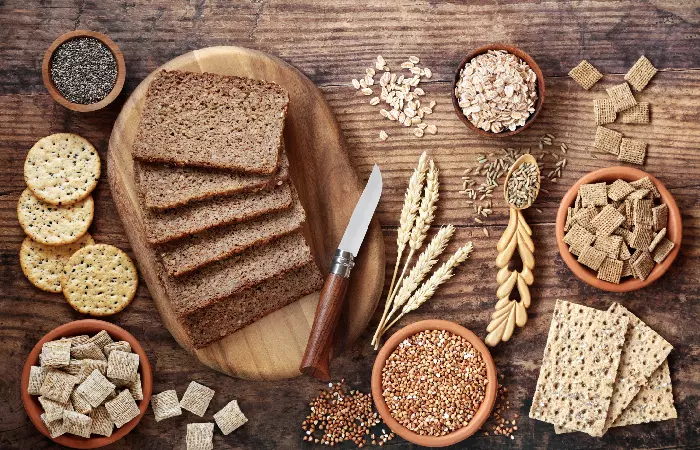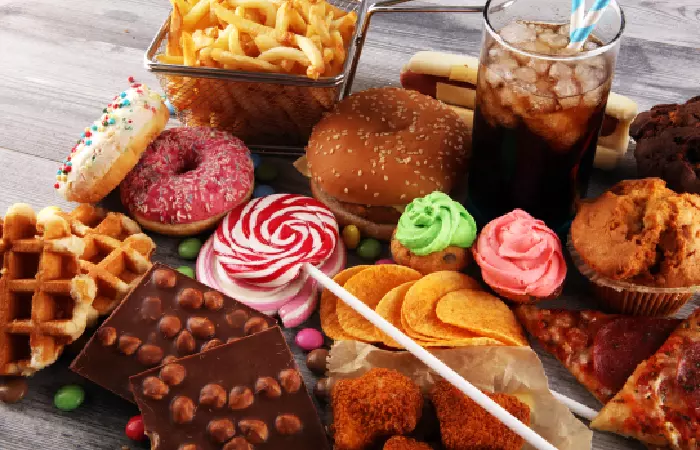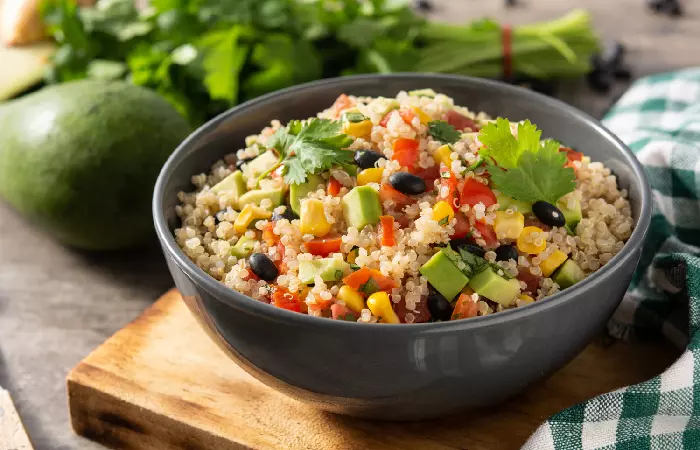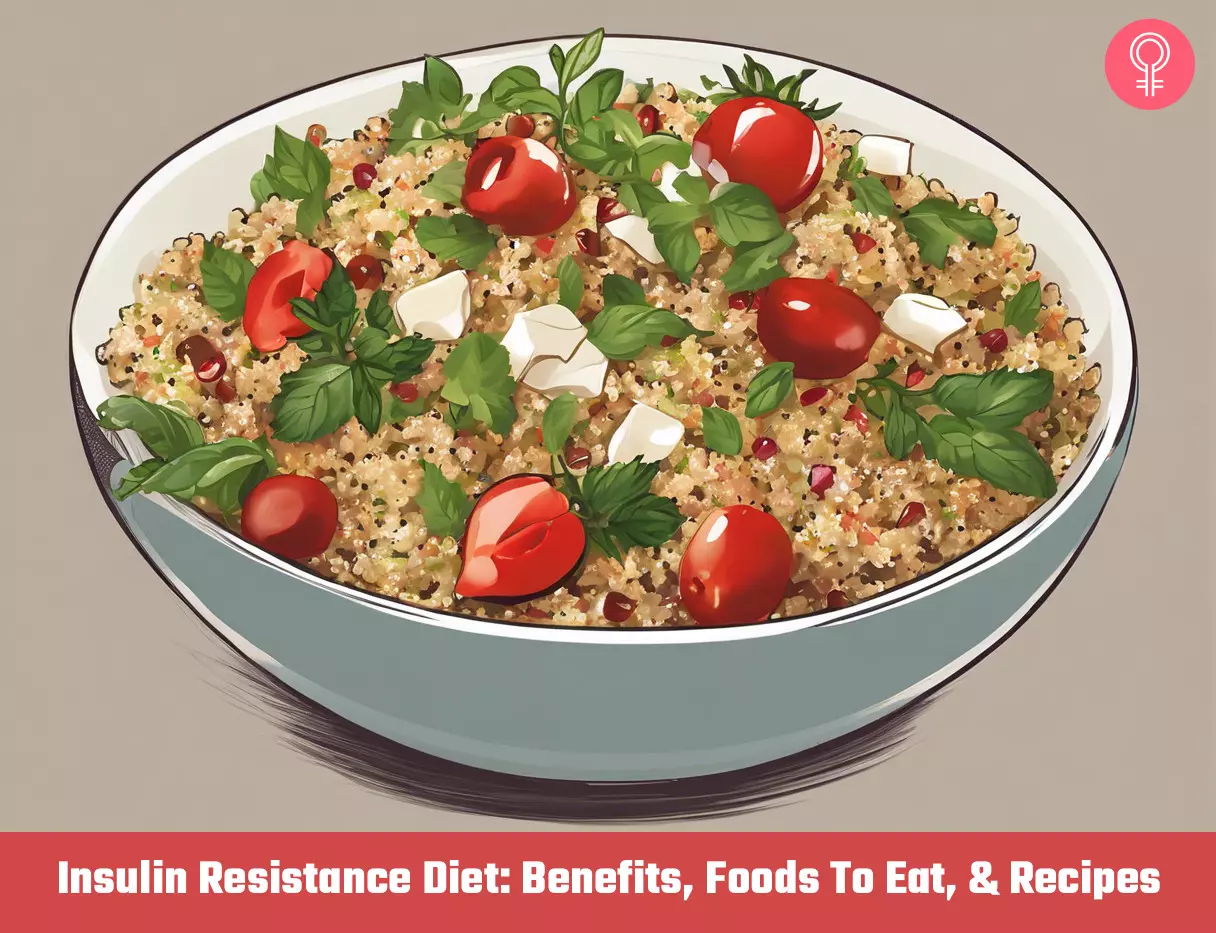What Is Insulin Resistance?
Human beings require a constant supply of energy to function and the primary source of this energy is glucose. The carbohydrates and proteins in foods are broken down into glucose by the digestive system (1).
When we eat, the pancreas releases the hormone insulin into the bloodstream. It ensures that the blood sugar levels remain within a healthy range, allows glucose to enter into our cells, and provides energy for various bodily functions. It also helps manage excess glucose by instructing the liver and muscles to store it for later use (1). However, insulin resistance, which develops due to genetics and a sedentary lifestyle, makes the cells less responsive to the insulin’s signals. Consequently, glucose struggles to enter the cells effectively, leading to higher blood sugar levels. This can increase the risk of type 2 diabetes, hypertensioni A chronic condition where the blood exerts too much force on the artery walls, increasing the risk of stroke and heart disease. , dyslipidemiai Elevated levels of cholesterol or fats in the blood, which increases the chance of clogged arteries or other circulatory problems. , and hyperuricemiai The presence of elevated levels of uric acid in your blood, which can lead to health issues such as gout or kidney stones. (2). Normal blood sugar levels typically range between 80 to 140 milligrams per deciliter (mg/dL) before and after meals, though these levels vary among individuals. If this value is elevated or inadequate, one might experience serious health risks (1). High blood sugar levels can damage the blood vessels and nerves. This increases the risk of heart disease, kidney problems, and eye damage. Extremely high levels can result in a dangerous condition called diabetic ketoacidosisi A life-threatening condition where extremely high blood sugar levels lead to the breakdown of ketones, resulting in acidic blood. (DKA), which requires immediate medical attention (3). Conversely, severely low blood sugar levels can cause symptoms like confusion, fatigue, tremors, anxiety, etc (4). Thus, it is necessary to regulate blood sugar levels, which is carried out by a hormone known as insulin. Insulin resistance is becoming a growing concern. An examination of the 2021 National Health and Nutrition Examination Survey (NHANES) data found that 40% of American adults between 18 and 44 years demonstrated signs of insulin resistance (2). Thus, it is crucial to follow a balanced diet and exercise regularly to manage insulin resistance. Scroll down to the next section to learn how your diet can support better blood sugar management.
What Is The Best Diet For Insulin Resistance?
The best diet for managing insulin resistance focuses on balancing blood sugar levels and making mindful food choices. Here are a few tips you may follow:
Incorporate fruits and vegetables rich in fiber and antioxidants like blueberries, apples, and grapes. They have anti-diabetic properties and may help enhance insulin sensitivityi The body’s ability to respond to the hormone insulin, which helps maintain healthy blood sugar levels. and lower blood glucose levels (5). Consume low-fat dairy products, as they offer calcium and protein. Include whole grains like oats and brown rice in your diet. They provide complex carbohydrates that improve insulin sensitivity and prevent blood sugar fluctuations (6), (7). Choose lean proteins and legumes. They are packed with fiber and protein, which may aid in blood sugar control (8).
Additionally, the best diet for insulin resistance focuses on the principles of the glycemic index (GI). It is a measure of how rapidly foods raise blood sugar levels. Consuming low-GI foods like apples, oranges, tomatoes, cucumbers, oats, barley, and non-starchy vegetables can be beneficial. They have a slower and steadier impact on blood sugar levels and help to prevent rapid spikes and crashes (9), (10). These foods are also included in a diabetes diet, which helps manage blood glucose levels and improve insulin sensitivity. Keep scrolling to learn how this diet can improve your overall health and well-being in the next section.
Health Benefits Of The Insulin Resistance Diet
1. May Help Control Blood Sugar Levels
The insulin resistance diet promotes the consumption of complex carbohydrates, fiber, and healthy fats, which helps slow down the sugar absorption process. This gradual release of sugar into the bloodstream prevents spikes and helps insulin work efficiently. This reduces the risk of developing diabetes (11).
2. May Help Boost Heart Health
This diet restricts the intake of saturated fats. Excess intake of these fats can lead to cholesterol buildup in your blood vessels. This buildup can narrow the arteries and increase the risk of heart disease. Thus, a diet low in saturated fats may help lower cholesterol levels and help reduce the risk of cardiovascular issues (12).
3. May Boost Energy Levels
Complex carbs like whole grains and legumes provide a consistent source of energy throughout the day, preventing energy spikes and crashes (13). Since this diet emphasizes the intake of complex carbs, it may help improve your daily productivity.
4. May Reduce The Risk Of Chronic Diseases
The diet focuses on low-GI foods rich in healthy fats and essential vitamins and minerals that may aid in weight loss and enhance insulin sensitivity (14). It may also help prevent various health complications like type 2 diabetes, obesity, and high blood pressure.
5. May Aid In Weight Management
Consuming low-GI and fiber-rich foods may prevent rapid blood sugar spikes and crashes. This also reduces cravings for sugary and high-calorie foods and helps you develop healthier eating patterns. This may lead to weight loss over time and improve insulin sensitivity (15). While an insulin resistance diet may help you get started on your weight loss journey, it can be challenging. But don’t worry. The following section provides you with tips on how to lose weight if you have insulin resistance.
How To Lose Weight When You Have Insulin Resistance
The following tips can help you lose weight if you have insulin resistance:
1. Follow A Balanced Diet
Consume whole foods like fruits, vegetables, lean proteins, and whole grains to keep your body nourished and full (16). Avoid sugary and processed foods that can spike blood sugar levels and decrease insulin sensitivity (17). Such foods are also high in calories. Therefore, restricting them may help you manage your weight.
2. Adopt A Regular Exercise Routine
Incorporate physical activity into your routine. Even a short walk or aerobic exercise for 30 minutes, 3-5 days a week, can help improve insulin sensitivity and aid in weight loss (18).
3. Exercise Portion Control
Smaller, frequent meals can help improve insulin secretion and stabilize blood sugar levels. A study on healthy men with impaired glucose tolerance found that having nine smaller but frequent meals daily could improve glucose metabolism (19). Additionally, being mindful of your portion sizes may help avoid overeating.
4. Keep Yourself Hydrated
Sometimes, you might mistake thirst for hunger. Hence, drink plenty of water daily to minimize cravings and unnecessary snacking.
5. Rest Well
Poor sleep can affect the production of hunger hormones like ghrelin, increasing appetite and encouraging overeating. This makes weight loss more challenging (20). Make sure you get enough quality sleep every day.
6. Manage Your Stress Levels
High stress levels trigger the release of cortisol, a hormone that can impact weight and insulin resistance, disrupting blood sugar control (21). Manage stress through relaxation techniques such as meditation or deep breathing. Most importantly, talk to your doctor or registered dietitian to create a personalized plan that aligns with your health goals and needs. Remember that losing weight when your body is insulin-resistant may take time. Individual response may vary but these steps may help improve your health and make the journey more manageable. Making a few dietary changes can not only control your weight but also your blood sugar levels. Take a look at the key foods to include in your insulin resistance diet.
Foods To Eat On The Insulin Resistance Diet
1. Non-Starchy Vegetables
Spinach Kale Broccoli Cauliflower Brussels sprouts Bell peppers
2. Whole Grains
Quinoa Brown rice Oats Barley
3. Lean Proteins
Chicken breast Turkey Salmon Tofu Lentils Beans
4. Healthy Fats
Avocado Olive oil Nuts Seeds
5. Low-Glycemic Fruits
Berries Apples Pears Citrus fruits
6. Dairy/ Dairy Alternatives
Greek yogurt Almond milk Cottage cheese
Note: Opt for unsweetened and low-fat or no-fat options
7. Herbs And Spices
Cinnamon Turmeric Garlic Ginger
The insulin resistance diet also recommends avoiding or limiting a few foods from your daily diet. Take a look in the next section.
Foods To Avoid On The Insulin Resistance Diet
1. Sugary Foods And Beverages
Soda Candy Pastries Sugary cereals Fruit juices
2. Sugary Sauces And Condiments
Ketchup BBQ sauce Sweet salad dressings
3. High-Sugar Fruits
Watermelon Pineapple Grapes Mangoes
4. Refined Grains
White bread White rice Processed cereals
5. Saturated And Trans Fats
Fried foods Fatty cuts of meat Processed meats
6. Processed And Fast Foods
Fast food burgers and fries Processed microwave meals Instant noodles
7. Excessive Alcohol
These food recommendations can help you create your weekly meal plans and organize your grocery lists better. If you need help creating your insulin resistance weekly meal plan, scroll down to check our sample diet plan.
7-Day Insulin Resistance Diet Plan
You can adjust portion sizes and the meal as per your individual tastes and dietary goals. Take a look at the next section for some recipes you can try at home.
Insulin Resistance Diet: Delicious Recipes To Try
1. Lentil Soup
Recommended Serving Size: 1.5 cups Ingredients
1 cup of green lentils 8 oz of chicken breast 2 cups of mixed vegetables (carrots, celery, and bell peppers) 1 onion 3 cloves of garlic 6 cups of chicken broth 1 teaspoon of cumin 1/2 teaspoon of paprika Salt and pepper to taste Olive oil for sautéing
How To Prepare
Heat olive oil and sauté chopped onions and minced garlic in a large pan until fragrant. Add diced chicken and cook until browned. Stir in lentils, chopped mixed vegetables, cumin, and paprika. Pour in chicken broth, bring it to a boil, then simmer for 25-30 minutes. Season with salt and pepper to taste. Serve hot.
2. Mexican Quinoa Salad
Recommended Serving Size: 1.5 cups Ingredients
1 cup of cooked quinoa 1 cup of black beans 1 cup of corn kernels 1 cup of tomatoes 1/2 cup of red onion 1/4 cup of fresh cilantro Juice of 2 limes 1 teaspoon of chili powder Salt and pepper to taste
How To Prepare These scrumptious recipes can help you stay satiated and keep your blood sugar levels in check. However, you need an extra push to follow it effectively. Check out the following section to learn more.
Tips For Success On The Insulin Resistance Diet
Here are a few tips and tricks to adopt this diet successfully:
1. Set Realistic Goals
Set small, attainable goals and focus on gradual improvement. Implement the changes in your diet slowly. Give yourself a timeframe for achieving these goals. Gradually add more changes as you accomplish your goals to make the transition smoother and less overwhelming.
2. Focus on Simplicity
Make one or two simple changes at a time instead of completely overhauling your diet. These smaller modifications are easier to maintain and are more likely to become ingrained habits.
3. Be Kind to Yourself
If you slip up and have an indulgent meal or a sugary treat, do not be too hard on yourself. Instead, commit to getting back on track the next day as progress is not about perfection.
4. Learn From Your Setbacks
If you have a day where your food choices are not ideal, view it as a learning experience rather than a failure. Remember that your overall diet matters more than a single moment or day.
5. Do Not Skip Meals
Skipping meals can disrupt blood sugar levels and lead to overeating later. Stick to a routine of regular, balanced meals and snacks to keep your energy levels stable. Is it important to eat small, frequent meals with insulin resistance? Yes, eating small, frequent meals may help manage insulin resistance by preventing extreme blood sugar fluctuations and aid in weight management. How long does it take to see improvements with an insulin resistance diet? Improvements in insulin resistance can vary depending on the individual and their adherence to the diet. Some may notice changes in a few weeks, while others may see significant progress in a few months. Consistency and patience are essential in following an insulin resistance diet.
Illustration: Insulin Resistance Diet: Benefits Foods To Eat & Recipes
Discover more about the essential elements of an effective insulin resistance diet. Watch the video below to learn how these choices can help manage blood sugar and improve overall health.














